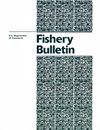化学时钟:利用耳石地球化学提高对白鳕(Urophycis tenuis)年龄和生长的估计
IF 0.8
4区 农林科学
Q3 FISHERIES
引用次数: 0
摘要
- 白无须鳕(Urophy-cis tenuis)是一种分布于缅因湾的底层鱼类。捕捞建议是根据基于年龄的种群动态模型进行的种群评估得出的;然而,由于生长增量不明确,耳石老化具有挑战性。为了解决这个问题,我们比较了用视觉年轮计数进行的老化与用激光烧蚀电感耦合等离子体质谱法测量的元素浓度周期进行的老化的一致性。我们测试了这样一个假设:环境条件和内部生理机能的波动会影响耳石矿化过程中对元素的吸收。与其他研究的微量元素(镁、锶和钡)相比,锰的浓度与目测生长增量的相关性最大(年龄一致性约为 100%,±1 年),为加强生长增量的识别提供了额外的工具。在对 2007-2021 年间收集的 550 块耳石的研究中,我们发现白无须鳕的最长寿命为 10.3 年,并在最长长度和年龄上表现出性双态性。通过使用生成的冯-贝塔朗菲生长函数,雄性为 L ( t )=110(1-e -0.113(t+0.45) ) ,雌性为 L ( t )=140(1-e -0.113(t-0.30) ) (其中 L ( t ) 为 t 时的长度),计算出雄性(总长 37.4 厘米,3.3 年)和雌性(总长 47.4 厘米,4.2 年)的体型和成熟年龄。这些结果表明,耳石地球化学可用于提高鱼类年龄和成熟度估计的准确性和精确度,即使是对具有挑战性的物种也是如此。本文章由计算机程序翻译,如有差异,请以英文原文为准。
Chemical clocks: using otolith geochemistry to enhance estimation of age and growth of white hake (Urophycis tenuis)
— The white hake ( Urophy-cis tenuis ) is a groundfish distributed throughout the Gulf of Maine. Catch advice is based on stock assessments done with age-based population dynamics models; however, otolith aging is challenging because of unclear growth increments. To address this concern, we compared the consistency of aging with counts of visual annuli to that of aging with cycles of elemental concentrations measured by using laser ablation inductively coupled plasma mass spectrometry. We tested the hypothesis that oscillations in both environmental conditions and internal physiology through time influence uptake of elements during otolith mineralization. Concentrations of manganese, in comparison with those of the other investigated trace elements (magnesium, strontium, and barium), had the most promising correlation with visual growth increments (~100% age agreement, ±1 year), offering an additional tool to enhance increment identification. In our examination of 550 otoliths collected during 2007–2021, we found that white hake lived a maximum of 10.3 years and exhibited sexual dimorphism in maximum length and age. By using generated von Bertalanffy growth functions, L ( t )=110(1−e −0.113(t+0.45) ) for males and L ( t )=140(1−e −0.113(t−0.30) ) for females (where L ( t ) is length at time t ), size and age at maturity were calculated for males (37.4 cm in total length (TL), 3.3 years) and females (47.4 cm TL, 4.2 years). These results demonstrate that otolith geochemistry can be used to improve the accuracy and precision of the estimation of fish age and maturity, even for challenging species.
求助全文
通过发布文献求助,成功后即可免费获取论文全文。
去求助
来源期刊

Fishery Bulletin
农林科学-渔业
CiteScore
1.70
自引率
12.50%
发文量
76
审稿时长
>24 weeks
期刊介绍:
The quarterly Fishery Bulletin is one of the oldest and most respected fisheries journals in the world. It has been an official publication of the U.S. Government since 1881, under various titles, and is the U.S. counterpart to other highly regarded governmental fisheries science publications. It publishes original research and interpretative articles in all scientific fields that bear on marine fisheries and marine mammal science.
 求助内容:
求助内容: 应助结果提醒方式:
应助结果提醒方式:


